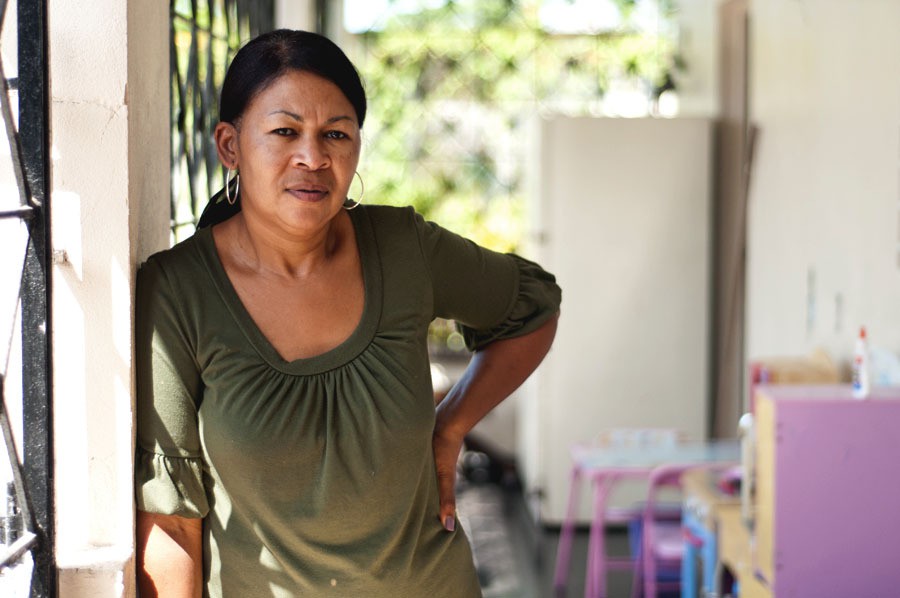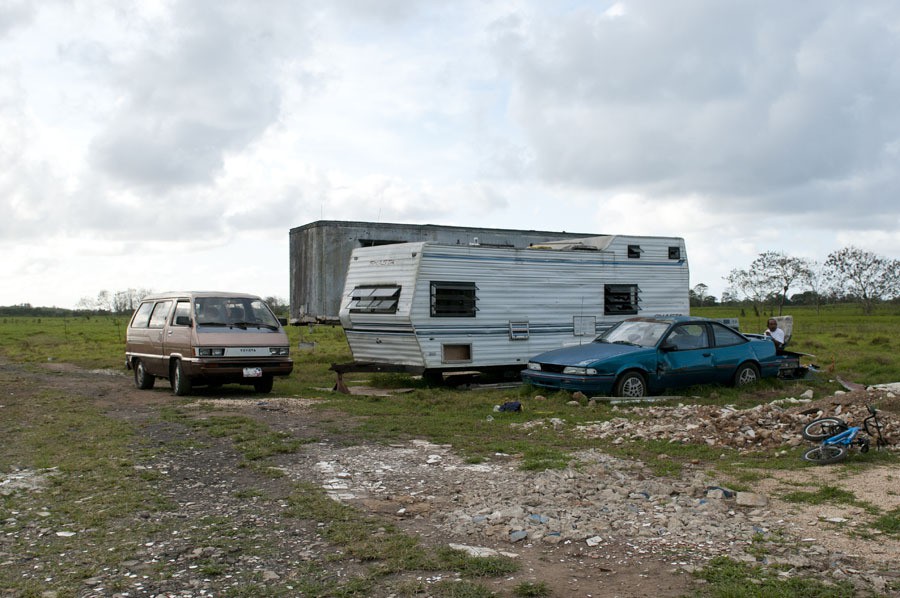Dominican Immigrants Fight for Land Rights in Puerto Rico
By Natasha Khan
Cronkite Borderlands Initiative
TOA BAJA, Puerto Rico -- A Dominican man sits on the edge of a couch in his rusty trailer, strumming an out-of-tune guitar with tan, calloused hands in this community just west of San Juan, Puerto Rico's capital.
A few minutes later a pickup truck whooshes by spilling water from huge metal barrels in the truck bed, a furious swarm of mosquitoes following close behind. The truck passes a thin brown pony tied to a pole outside a handful of dilapidated houses thrown together with sheet metal and concrete blocks. The houses sport pastel paint jobs -- flamingo pink and Caribbean blue.
The people who live here are squatters; they hold company with millions of poor people worldwide who build homes on land they don't own.
But something is different here; these squatters are on their own land.
Two Christmases ago they found themselves homeless along with 170 other families -- mainly poor Dominican women and children, many undocumented -- in Toa Baja, Puerto Rico, a municipality of almost 90,000 people. Their community, Villas del Sol, established a decade before on land they didn't own, was demolished in 2010 by the Puerto Rican government because it was illegally built on a dangerous flood plain.
The families garnered international attention when they banded together to try to resist the Puerto Rican government's eviction order. The community's women led the way, creating their own cooperative to have more power as a unified entity. Their cohesiveness and the publicity surrounding their plight led to an agreement in which the government set aside land where the community is now supposed to rebuild.
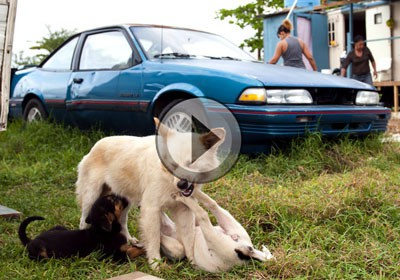 SLIDESHOW: Residents of new land in Toa Baja, Puerto Rico, are waiting for permission to legally live on land reserved for this largely Dominican community. Photo by Molly J. Smith. |
But the new development is stalled.
The families haven't been able to get the necessary permits to start building homes. The government has yet to install roads, sewer lines and other infrastructure. And infighting between community leaders has confused and divided the families.
"We are hard working families," said Laura Mota, vice president of the community cooperative. "We just need a lift up to make things go."
Mota is a Mexican-American from the mainland U.S. who followed her husband, an undocumented Dominican, to Puerto Rico.
That the community has gotten this far is extraordinary: the squatters -- many undocumented Dominicans -- are now land owners trying to plan, finance and build a new housing development.
"It was such a good project: immigrants who don't own the land coming to an agreement with the government. It had never been done before," said Maria Sanchez Bras from Puerto Rico's Department of Housing.
But what began as an innovative solution rapidly devolved into a bureaucratic waiting game and disagreements between members of the community. It's been almost a year and a half and many former Toa Baja residents are homeless, paying unaffordable rent in surrounding cities or staying with family members.
Six community members currently squat on the land that was reserved for them by the government, while a few others live in storage units on the community's original plot, from which they were evicted earlier.
They have no running water. They use generators for electricity by running extension cords to makeshift homes. They are constantly threatened with eviction -- by government officials concerned with health and safety issues and by fellow community members who say they shouldn't be living there at all.
"We are humble people, we want an adequate home," said Mota, who lives a few blocks away from the reserved land in a rat-infested house for which she struggles to pay the $500-a-month rent. "We want a safe home for our families to live in."
Mota lets the squatters take showers at her house and feeds them whenever she can.
A Human and Bureaucratic Saga
The saga of Villas del Sol began when the informal community's 17 original acres were designated a flood plain by the Federal Emergency Management Agency (FEMA) after Hurricane Georges hit Puerto Rico in 1998. FEMA granted the Puerto Rican government almost $17 million to relocate multiple squatter settlements in Toa Baja under a program called the New Secure Housing Program.
In all, three squatter communities were relocated. But 20-25 families resisted and remained, eventually rebuilding Villas del Sol. In the next 10 years the community grew to more than 200 families with housing ranging from small wooden shacks to sturdy 2,000-square-foot ranch-style homes.
After years of looking the other way Puerto Rican government officials say they were forced by FEMA to take action. The federal agency threatened to take back $180 million in general disaster relief funding, according to Puerto Rican Secretary of State Kenneth McClintock.
"Now really, if you have 100 families as squatters on a piece of land, is that really worth 180 million dollars?" McClintock said in an interview at his office in historic Old San Juan.
In August 2009 the Puerto Rican government tried to force the squatters off their original land by cutting off the supply of water and electricity and setting up a 24-hour police barricade. The residents lived nearly nine months without water and lights, which they were previously obtaining illegally.
"I think that was the worst nightmare," Mota said. "Water is life. Without water you're nothing."
Dengue fever and H1N1 emerged because of the poor living conditions and children started getting sick. This set off a frenzy of protests, media campaigns and involvement from the American Civil Liberties Union and Amnesty International.
On August 3, 2009, some of the resisting community members were tasered, beaten and tear-gassed. The incidents were cited in a U.S. Department of Justice 2011 report on police brutality in Puerto Rico.
Maritza De la Cruz said she was beaten on her pregnant stomach and her then 6-year-old son, Christopher, was tear-gassed in the face.
Mota said townspeople would say cruel things like "they don't deserve water" and "catch them on fire."
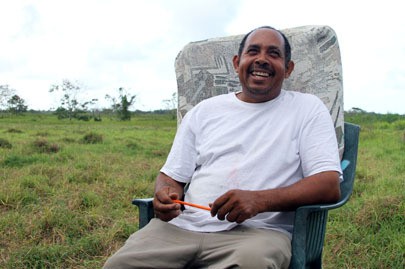
Jose 'Mellito' Taveras sits outside in the cool afternoon. He is squatting for the time being, waiting for the permits to build his home. Photo by Fara Illich |
"We are human," she said. "With papers or without, every individual is a human being and has a right to anything in life."
The ACLU accused the Puerto Rican government and police of intentionally targeting the community because many residents were Dominican immigrants, some of them undocumented. According to the U.S. Census Bureau, there are 68,306 Dominicans living in Puerto Rico. Dominican Consul Maximo Taveras believes it to be closer to 200,000.
Dominicans say they experience discrimination on a regular basis.
A few University of Puerto Rico students came to the aid of the squatters, standing with them during protests. Legions of lawyers descended on the community and worked pro bono to fight the eviction.
A concentrated effort by the ACLU got the water and electricity turned back on, after several failed attempts to spur the U.S. and Puerto Rican governments to action. The ACLU eventually appealed to the Inter-American Commission on Human Rights in Washington D.C., citing multiple human rights violations.
"I think the government just wanted to teach this community a lesson so other communities do not spring up," said the ACLU's William Ramirez. "It is also easier to target undocumented immigrants then it is to target citizens."
The community eventually signed an agreement to vacate the land and left on Dec. 31, 2010. They say they were told they would be given new land on which to build in less than a year. They watched as their homes, the only houses some of them had ever owned, toppled to the ground behind the massive blades of bulldozers sent by the government.
'Invaders' or 'Land Rescuers'?
The legitimacy of the squatter movement lies in the eyes of the beholder.
Some government officials in Puerto Rico call squatters "invaders." The squatters themselves say they are engaged in "rescate de terreno"-- "land rescue."
Rescates have a rich history of political and social activism in Puerto Rico dating back to the 1940s when poor rural farmers started moving to the cities, according to Liliana Cotto, an urban sociologist and a leading authority on squatter settlements in Puerto Rico.
"This name [rescates] started a struggle that qualifies as a righteous one, because it was perceived that society had not been able to or had not wanted to meet the basic housing needs of the poorest sectors," she wrote in her 2011 book, Desalambrar, which means "break down the wall" in Spanish.
According to William Ramirez, executive director of the American Civil Liberties Union in Puerto Rico, the conflict can be summed up in a few words: a lot of poor people and too little land that is suitable for building houses.
The island territory is about 100 miles long by 35 miles wide. It is roughly the size of Connecticut, and has a population of nearly 3.8 million. The poverty rate is 44 percent, double that of Mississippi, the poorest U.S. state.
"Squatters are the way which poor people design and build their own communities," said Edwin Morales, architect and planner at the School of Architecture at the University of Puerto Rico, who has worked with squatter communities for nearly 40 years. "When the market doesn't attend to their needs, they have to find ways to get some place to live."
Toa Baja Mayor Anibal Vega Borges, who played an integral role in the demolition of the original Villas del Sol homes, said he understands the poor have a great need for housing in Puerto Rico.
"Land invasions are going to continue and the people are going to be reclaiming some lands because they have a demand for land that the government is not supplying," Vega said.
The Life of a Squatter
Just down the road from the mayor's office Jesus Nuñez is playing his guitar and singing a soft Dominican love song. He's in a trailer he placed illegally on the new land given to Villas del Sol.
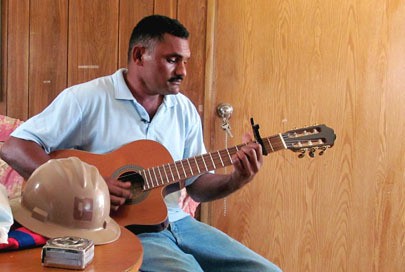
Jesus Nuñez illegally placed a trailer on the new land given to the Villas del Sol community because he was unemployed and couldn't pay his rent. Photo by Danielle Verbrigghe |
"I'm in love, I feel a great love for her," he sings in Spanish.
There's no work today so his construction hat sits nearby. He lives alone, but there are remnants of a former life: a bright yellow stuffed animal and pink floral sheets that look like they were chosen with a woman's touch.
His wife Zenieda, the former secretary of the Villas del Sol cooperative, was deported to the Dominican Republic in early 2012. The couple's 10-year-old daughter went with her.
He doesn't want to elaborate on the story -- he is undocumented, too.
Nuñez's trailer sits amid a few wooden shacks on land sprinkled with shards of cement blocks that are used as filler to keep mud holes from forming.
The few squatters living here take up a small slice of the land on which the community was given to resettle. The rest is green and open with tall unkempt grass and piles of forgotten tile dumped here and there to level the terrain before building can begin.
Nuñez moved here in December 2011 because he was unemployed and couldn't pay his rent. He lives on the plot of land that was assigned to him when it was transferred to the Villas del Sol cooperative from the city government of Toa Baja.
Some community members don't want the squatters on the land but the squatters say they have little choice.
"They told us that no one can live here, and I understand that's true," Nunez said, sitting on the arm of a couch in his trailer. "Further into the future we can but right now no -- but I don't understand why."
A Sense of Family and Community
Today, the families of Villas del Sol long for their community's reconstruction on the new parcel of land reserved by the government.
They believe something priceless was lost after the eviction from their original community.
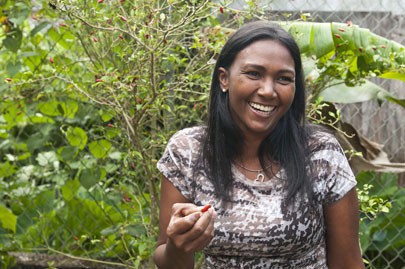
Maritza de la Cruz, 34, in her backyard in Toa Baja. De la Cruz is the community president in Villas del Sol and a legalized Dominican immigrant. Photo by Molly J. Smith |
"I came here wet and salty," said Maritza De la Cruz, president of the Villas del Sol cooperative as she bounces her daughter, Marisol, on her lap while the two-year-old messily devours an ice cream treat outside their home in Toa Baja. It is hot and her neighbor's cockfighting roosters crow noisily in their cages.
De la Cruz came to Puerto Rico on a makeshift wooden boat commonly known as a yola, that traveled 165 miles across the choppy waters of the Mona Passage from the Dominican Republic -- a harrowing journey taken by hundreds of illegally immigrating Dominicans each year.
"I'm not embarrassed to say I came here illegally because in that moment it was a decision for the life of my two children that I had in Santo Domingo," she said.
In the Dominican Republic, De la Cruz lived with her two children, grandfather and brother on a farm that grew cocoa and rice. The family also raised cows and pigs, but they didn't make enough money to pay the bills.
"[You] can't get out of poverty there, you are submerged in poverty there," she said.
When she was pregnant with a third child De la Cruz left her two young children with relatives and struck out for Puerto Rico, a U.S. territory. She planned to send money home and provide a better life for her unborn child.
"If you are a single mother living with your children, trying to get through life, you are probably going to get into a yola and come to the U.S. illegally and try to get your documents," she said.
De la Cruz said she has her documents now and still sends money to the two children she left in the Dominican Republic. She also now has two children who were born in Puerto Rico. They are U.S. citizens.
Del la Cruz and her husband came to Villas del Sol in 2004 looking for an affordable place to live. She was the only one working at the time and the couple couldn't afford rent and utilities in traditional housing developments. The couple worked morning and night to build their small home.
"My house was very beautiful," she said. "I felt like it was a palace or a mansion."
The house was destroyed after the community agreed to leave the original parcel of land in 2010.
De la Cruz's story is similar to many Villas del Sol community members.
They risked their lives coming to Puerto Rico on yolas. They work long hours doing manual labor when they can find it. The men work construction and the women work mainly as housekeepers and nannies, making $60-$80 a day according to one community member. Many of them have children who are Puerto Rican and therefore U.S. citizens. Many of them left other children and family behind in the Dominican Republic.
But they all said they found a home and a sense of community in Villas del Sol.
"An environment of family, it doesn't have a value," said De la Cruz. "It's priceless."
A Lack of Planning and Policy
The Puerto Rican government has no policy in place for dealing with established squatter communities, says to Dickson Ortiz, the legal director for the Puerto Rican Land Authority.
"I think Villas del Sol, it's a clash, because it's the first one that the government felt the heat from the government agency of the United States," Ortiz said.
For years, whenever natural disasters would occur, FEMA would give money to Puerto Rico to relocate communities off of floodplains, Ortiz said.
"The people saw that OK, I want to be part of an invasion because sooner or later they are going to have a good house in upland," he said. "In some way, the solution made the problem bigger. Because people saw that sooner or later they're going to move me to another place, a good house."
In the case of Villas del Sol, FEMA gave the Puerto Rican government millions of dollars to relocate families from the designated flood plain -- the community's original land. In 1999 most of the families were relocated to an upland neighborhood called Campanillas. However, 20-25 families remained and rebuilt Villas del Sol, which mushroomed to more than 200 families by 2007.
Ortiz said FEMA's reaction was: "That's all, I'm not going to do it again. I'm not going to bring more money. You take those people out of this place or return me the money I offered you to make those houses."
But in a stroke of charitable fortune, a wealthy Mexican doctor, Eduardo Ibarra, who had been watching the drama unfold, donated 17 acres of land in 2009 to the Villas del Sol community in the coastal town of Arecibo, located in the northwest of the island. The government deemed that land a natural resource and swapped it for another piece of land located in Toa Baja -- near the original settlement.
This is the "new land," set aside by the government especially for the Villas del Sol families. It was all made possible by Ibarra's donation.
"I think everybody in the world that has a little extra land that is doing nothing, producing nothing, should help these poor people that are suffering so much," Ibarra said in March at a Villas del Sol meeting to discuss the future of the community.
An Uncertain Future
The end of the Villas del Sol story is still unwritten. Mayor Vega projects that it will be another two years before the community can legally move onto the new land.
"The more money the government contributes, the cheaper the cost for them for infrastructure and that's what's being worked on, to identify or secure federal funds with proposals to develop these homes," he said.
The designers say they can't start until the roads and sewers are built.
"We are waiting for Vega Borges to do the infrastructure," said Elio Martinez, an architect from the University of Puerto Rico who leads a group of students who are designing the new Villas del Sol community.
The community is trying to get loans to build their homes but the process is slow. There are disagreements between the leaders of the community.
Some leaders want to strike a deal where every family would take out a $65,000 home loan. But when you are only making $60-$80 a day and not consistently working, this is unrealistic, Laura Mota said.
Martinez agrees. "I don't know who is going to lend them the money because in Puerto Rico no one is lending money for building anything right now," he said in a phone interview.
Many people have ideas for where and how the community should live. Mota, who has become one of the outspoken voices in the community, wants the community members to build their own homes, similar to what they did in the old community.
She is searching for Habitat for Humanity-like charities that might help the community build and regain its autonomy. But she says the community is growing impatient with the bureaucratic processes and how long it is taking to proceed.
"I'm worried about the families. And if we gotta go in there without a permit, I'm gonna do it," Mota said.
But the government doesn't want the community to be built as it was before.
"At the moment they can go in and do what they did, poor homes, this and that, which is what we don't want," said Mayor Vega.
The years of fighting to stay on the land, living without light and water, the confrontations with police and finally negotiating what seemed like a sensible solution have left even the most ardent supporters demoralized and frustrated. They wonder if their community will ever rise again.
"I mean where is our promise, our dignity? We negotiated for this right and we are going to pay for it. We are not asking for it for free. And it's still not there," Mota said, gazing out at the empty land.
"Having a home where you can be with your family means more than you can ever imagine," Mota said.
Back to Top
